Structural Effects of Mass Distributions in a Floating Photovoltaic Power Plant
Abstract
1. Introduction
2. Geometric Details of the Pilot PV Platform
3. Hydrodynamic Analyses
3.1. Theoretical Background
3.2. Hydrodynamic Analysis Model
3.3. Hydrodynamic Analysis Results
4. Structural Analysis
4.1. Structural Analysis Model
4.2. Structural Analysis Result
5. Conclusions
Author Contributions
Funding
Institutional Review Board Statement
Informed Consent Statement
Data Availability Statement
Conflicts of Interest
References
- World Bank Group. Where Sun Meets Water; Floating Solar Market Report; Worldbank: Washington, DC, USA, 2018. [Google Scholar]
- International Energy Agency. Snapshot of Global Photovoltaic Market 2020; IEA: Paris, France, 2020. [Google Scholar]
- British Petroleum. Statistical Review of World Energy; BP: Poole, UK, 2020. [Google Scholar]
- American Society of Civil Engineers. Pre-Standard for Load and Resistance Factor Design of Pultruded Fiber Reinforced Polymer Structures; ASCE: Reston, WV, USA, 2010. [Google Scholar]
- American Institute of Steel Construction (AISC). Steel Construction Manual—Allowable Stress Design, 9th ed.; AISC: Chicago, IL, USA, 1989. [Google Scholar]
- American Petroleum Institute. Recommended Practice for Design and Analysis of Station Keeping Systems for Floating Structures; American Petroleum Institute (API): Washington, DC, USA, 2005. [Google Scholar]
- Det Norske Veritas (DNV). Design, Development and Operation of Floating Photovoltaic Systems; DNV-RP-0584; DNV: Oslo, Norway, 2021. [Google Scholar]
- Kim, K.; Kim, T.; Kim, N.; Kim, D.; Kang, Y.; Kim, S. Evaluating the Mechanical Properties of Fiber Yarns for Developing Synthetic Fiber Chains. J. Ocean Eng. Technol. 2021, 35, 426–433. [Google Scholar] [CrossRef]
- Chung, J.C.; Lee, M.M.S.; Kang, S.H. A Study of 100 tonf Tensile Load for SMART Mooring Line Monitoring System Considering Polymer Fiber Creep Characteristics. J. Ocean Eng. Technol. 2021, 161, 266–272. [Google Scholar] [CrossRef]
- Kim, H.S.; Kim, B.W.; Hong, S.Y.; Lee, K.S. Dynamic Analysis on Module Type Floating Structure Consisting of Highly Numerous Buoys and Connection Beams. In Proceedings of the 28th International Conference on Ocean and Polar Engineering, Sapporo, Japan, 10–15 June 2018. [Google Scholar]
- Kim, Y.S.; Choi, E.; Yoon, S.J.; Lee, S.O. Three dimensional hydrodynamic-structural analysis of floating type photovoltaic composite structure. In Proceedings of the Advances in Interaction & Multiscale Mechanics (AIMM’10), Jeju, Korea, 30 May–3 June 2010. [Google Scholar]
- Li, W.; Zhou, L.L.; Gan, J.; Wu, W.G. Finite Element Analysis of Photovoltaic Floating Body Based on Design Wave Method. In Proceedings of the 28th International Conference on Ocean and Polar Engineering, Sapporo, Japan, 10–15 June 2018. [Google Scholar]
- Yoon, S.; Joo, H.; Kim, S. Structural analysis and design for the development of floating photovoltaic energy generation system. In Proceedings of the IOP Conference Series: Materials Science and Engineering, Kitakyushu, Japan, 10–13 April 2018; Volume 372, pp. 12–21. [Google Scholar]
- Lee, Y.G.; Yoon, S.J.; Joo, H.J.; Nam, J.H. Modified Design of Floating Type Photovoltaic Energy Generation System. J. Korean Soc. Adv. Comp. Struc. 2010, 1, 18–27. [Google Scholar]
- Lin, Z.; Liu, X.L. Sustainable Development of Decommissioned FPSO as a Floating Solar Plant—Case Study of the Effects of Tilt Angle on Energy Efficiency. In Proceedings of the 11th International Conference on Applied Energy, Vasteras, Sweden, 12–15 August 2019. [Google Scholar]
- Son, B.H.; Jeong, S.M. Numerical Study on the Improvement of the Motion Performance of a Light Buoy. J. Ocean Eng. Technol. 2019, 34, 66–76. [Google Scholar] [CrossRef]
- Cho, I.H. Effect of Internal Fluid Resonance on the Performance of a Floating OWC Device. J. Ocean Eng. Technol. 2021, 35, 216–228. [Google Scholar] [CrossRef]
- Ansys. Aqwa User Manual; Technology Drive: Harrisburg, PA, USA, 2020. [Google Scholar]
- Pastor, J.; Liu, Y.C. Wave climate resource analysis based on a revised gamma spectrum for wave energy conversion technology. Sustainability 2016, 8, 1321. [Google Scholar] [CrossRef]
- Pastor, J.; Liu, Y.C. Power absorption modeling and optimization of a point absorbing wave energy converter using numerical method. J. Energy Res. Technol. 2014, 136, 021207. [Google Scholar] [CrossRef]
- Li, C.B.; Choung, J. A new method of predicting hotspot stresses for longitudinal attachments with reduced element sensitivities. Int. J. Nav. Archit. Ocean Eng. 2021, 13, 379–395. [Google Scholar] [CrossRef]
- Li, C.B.; Seo, J.K.; Paik, J.K. Proposed formulas for evaluation of the equivalent material properties of a multiholed structures. Ocean Eng. 2016, 121, 312–322. [Google Scholar] [CrossRef]
- Li, C.B.; Choung, J. Fatigue damage analysis for a floating offshore wind turbine mooring line using the artificial neural networkapproach. Ships Offshore Struct. 2016, 12, 288–295. [Google Scholar] [CrossRef]
- Li, C.B.; Choung, J.; Noh, M.H. Wide-banded fatigue damage evaluation of Catenary mooring lines using artificial neuralnetworks models. Mar. Struct. 2018, 60, 186–200. [Google Scholar] [CrossRef]
- Li, C.B.; Chen, M.; Choung, J. The quasi-static response of moored floating structures based on minimization of mechanical energy. J. Mar. Sci. Eng. 2021, 9, 960. [Google Scholar] [CrossRef]
- Li, C.B.; Choung, J. Effects on strain-and strain rate-dependent nonlinear mooring line stiffness on floating platform motion. Ocean Eng. 2021, 241, 110011. [Google Scholar] [CrossRef]
- Solar Frame. Available online: https://aluminumsolarframe.com/what-is-the-solar-panel-thickness-in-2020/ (accessed on 25 December 2021).
- Engineering ToolBox. Available online: https://www.engineeringtoolbox.com/ (accessed on 25 December 2021).
- Li, C.B.; Choung, J. Prediction of stress spectra under low-period sea states. Ships Offshore Struct. 2018, 13, 56–67. [Google Scholar] [CrossRef]
- Korea Hydrographic and Oceanographic Administration (KHOA). Korea Real Time Database for NEAR-GOOS; KHOA: Busan, Korea, 2021; Available online: https://www.khoa.go.kr/koofs (accessed on 21 November 2021).
- Det Norske Veritas (DNV). Environmental Conditions and Environmental Loads; DNV-RP-C205; DNV: Oslo, Norway, 2014. [Google Scholar]
- Liu, Y.C.; Pastor, J. Time domain modeling & power output for a heaving point absorber wave energy converter. In Proceedings of the ASME 2014 International Mechanical Engineering Congress & Exposition, Montreal, QC, Canada, 14–20 November 2014. [Google Scholar]
- Pastor, J.; Liu, Y.C. Frequency and time domain modeling and power output for a heaving point absorber wave energy converter. Int. J. Energy Env. Eng. 2014, 5, 101. [Google Scholar] [CrossRef]
- Simulia. Abaqus User Manual; Abaqus: Vélizy-Villacoublay, France, 2020. [Google Scholar]
- Bureau Veritas (BV). Spectral Fatigue Analysis Methodology for Ships and Offshore Units; Guidance note NI 539 DT R00E; Bureau Veritas (BV): Paris, France, 2008. [Google Scholar]
- Det Norske Veritas (DNV). Fatigue Assessment of Ship Structures; Classification Notes No. 30.7; DNV: Olso, Norway, 2014. [Google Scholar]
- American Bureau of Shipping (ABS). Spectral-Based Fatigue Analysis for Vessels; ABS: New York, NY, USA, 2016. [Google Scholar]
- Bishop, N.W.M.; Feng, Q.; Schofield, P.; Kirkwood, M.G.; Turner, T. Spectral fatigue analysis of shallow water jacket platforms. J. Offshore Mech. Arct. Eng. 1996, 118, 190–197. [Google Scholar] [CrossRef]
- Ragan, P.; Manuel, L. Comparing estimates of wind turbine fatigue loads using time-domain and spectral methods. Wind Eng. 2007, 31, 83–99. [Google Scholar] [CrossRef]
- Zhang, Y.; Shi, W.; Li, D.; Li, X.; Duan, Y.; Verma, A.S. A novel framework for modeling floating offshore wind turbines based on the vector form intrinsic finite element (VFIFE) method. Ocean Eng. 2022, 262, 112221. [Google Scholar] [CrossRef]
- Choung, J.; Yoon, K.Y. Fully stochastic fatigue analysis for FPSO based on shipyard practices. Int. J. Offshore Polar. 2008, 18, 142–148. [Google Scholar]
- American Institute of Steel Construction (AISC). Specification for Structural Steel Buildings; AISC: Chicago, IL, USA, 2015. [Google Scholar]
- European Committee for Standardization (CEN). Eurocode 3 Part 1.1–1.5; CEN: Brussels, Belgium, 2005. [Google Scholar]

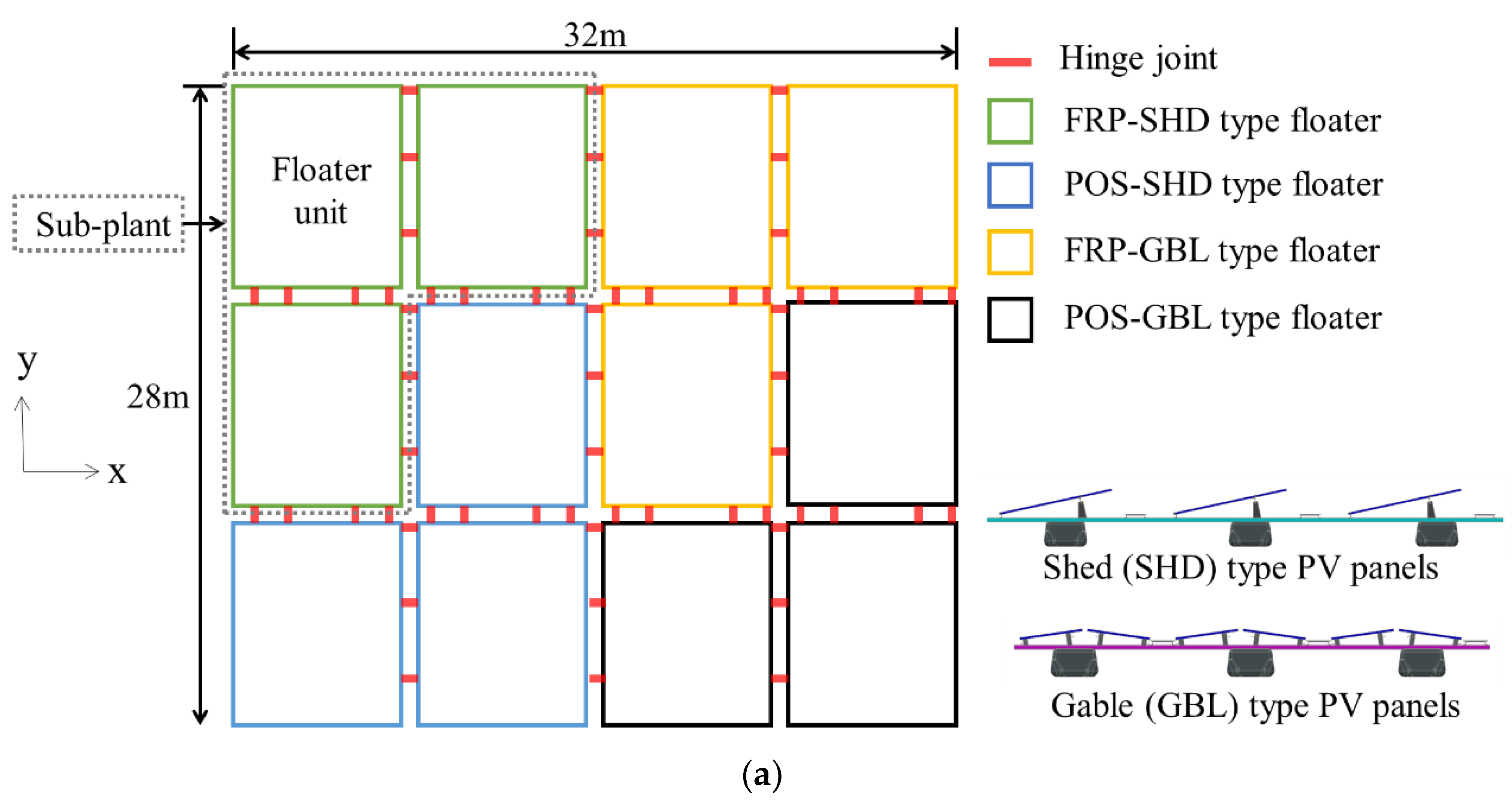
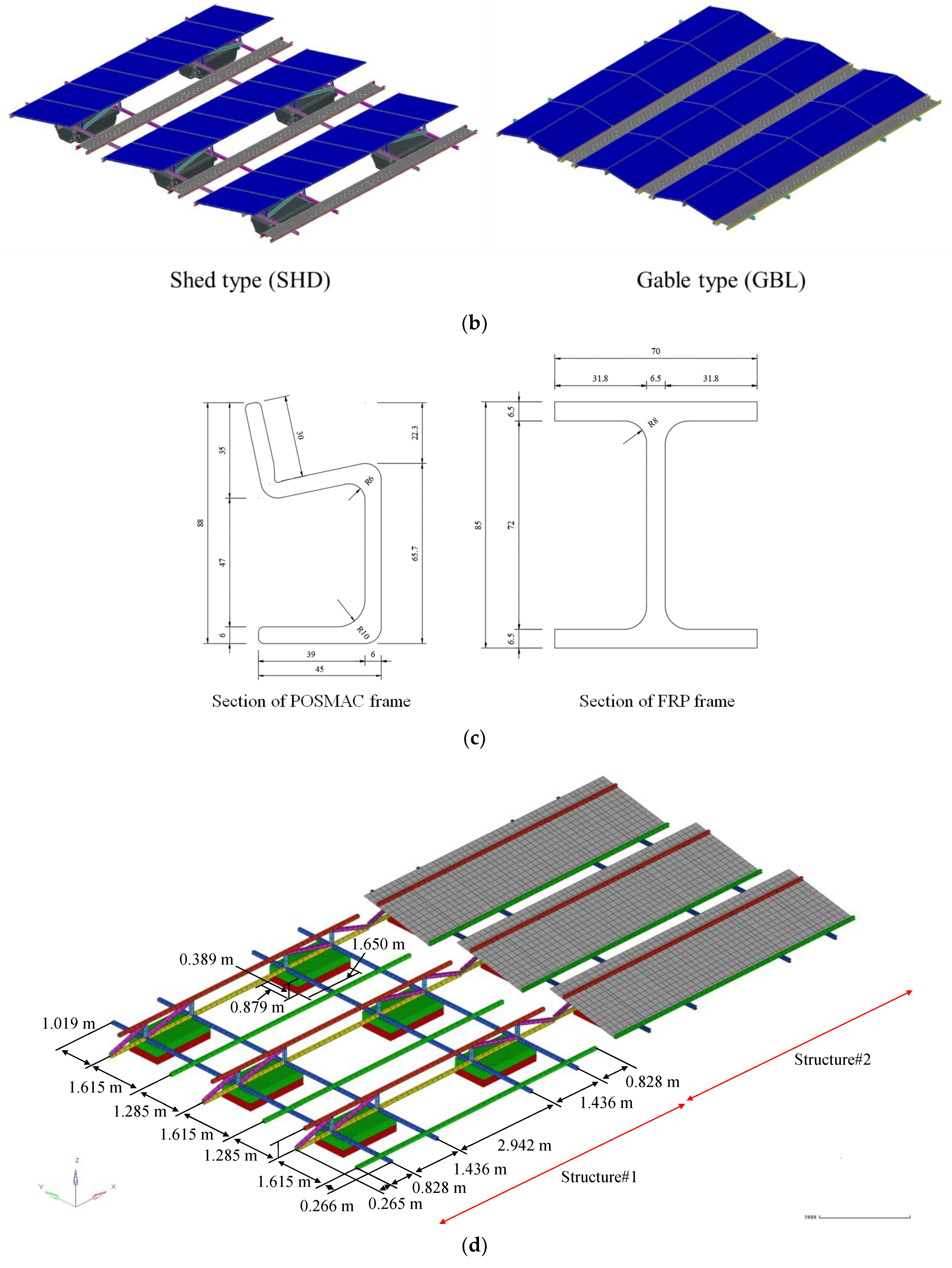
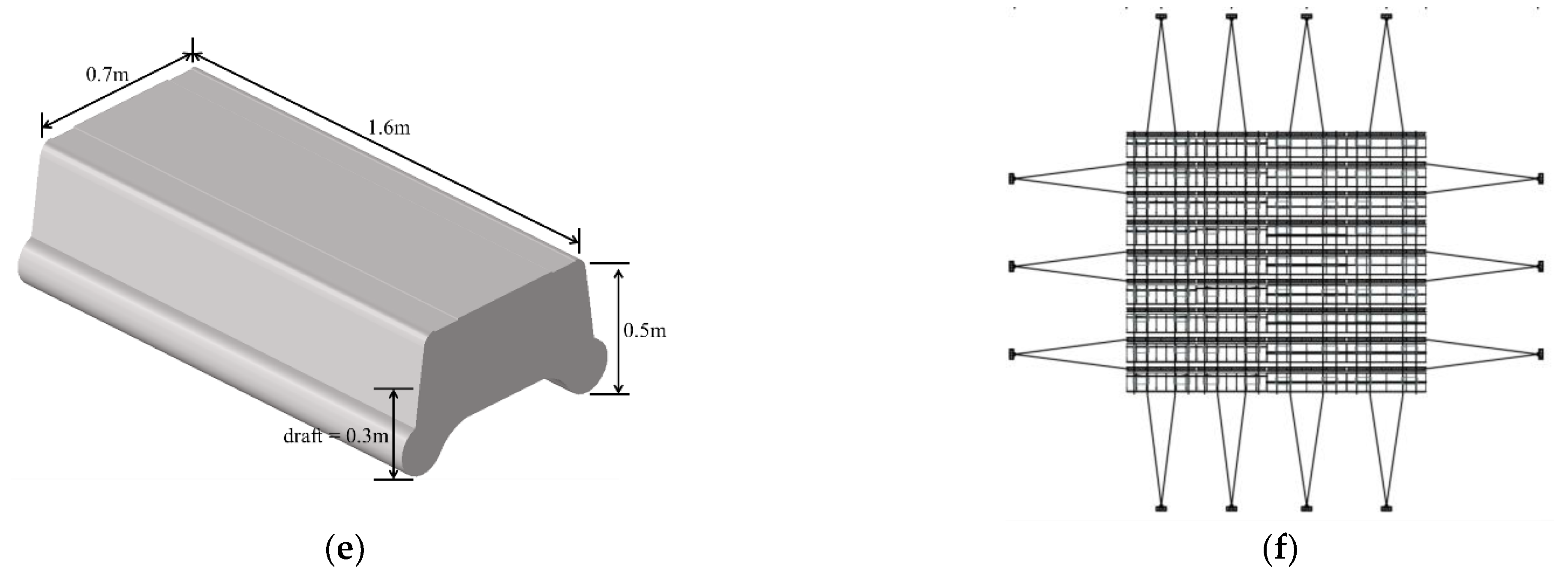


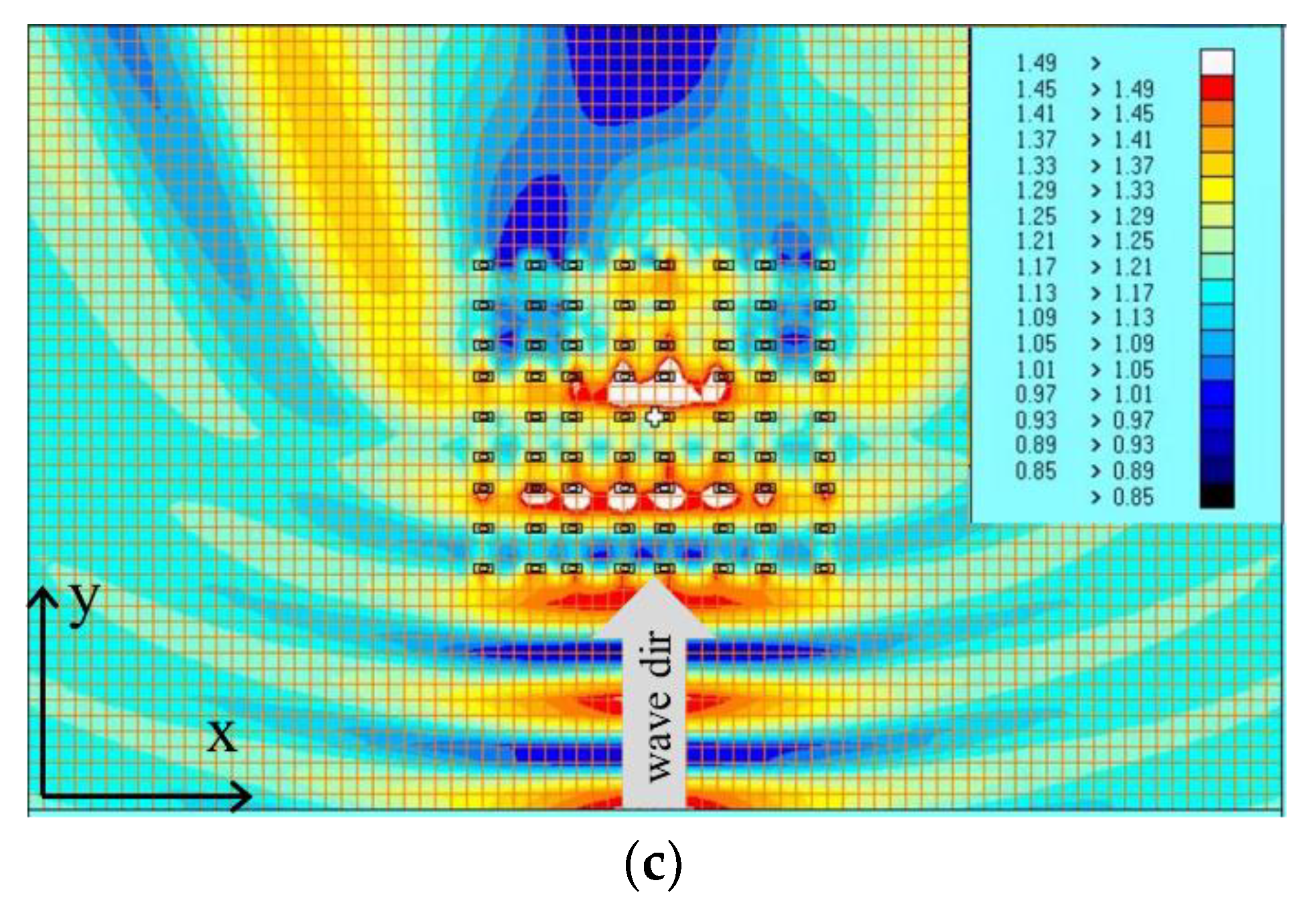
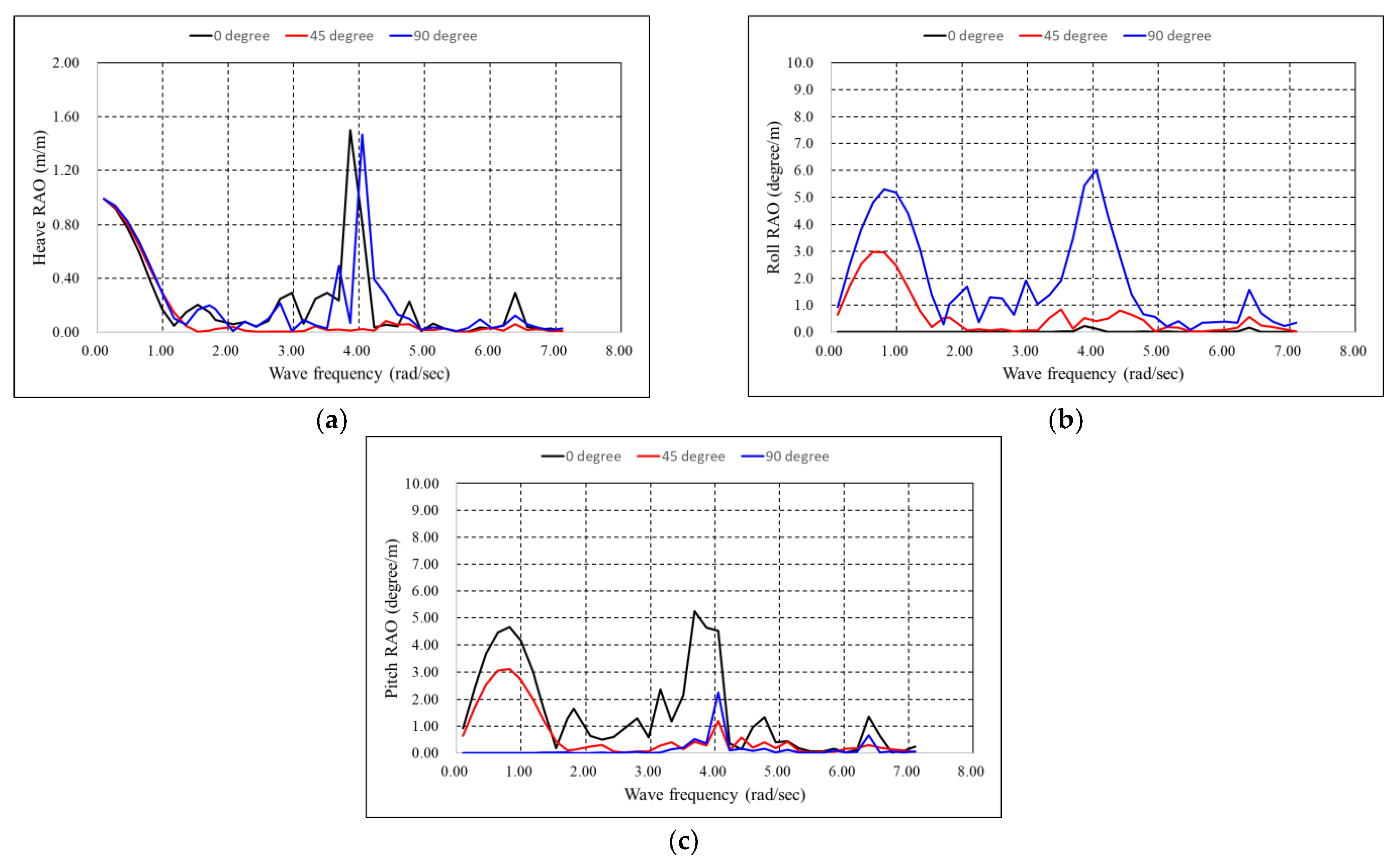

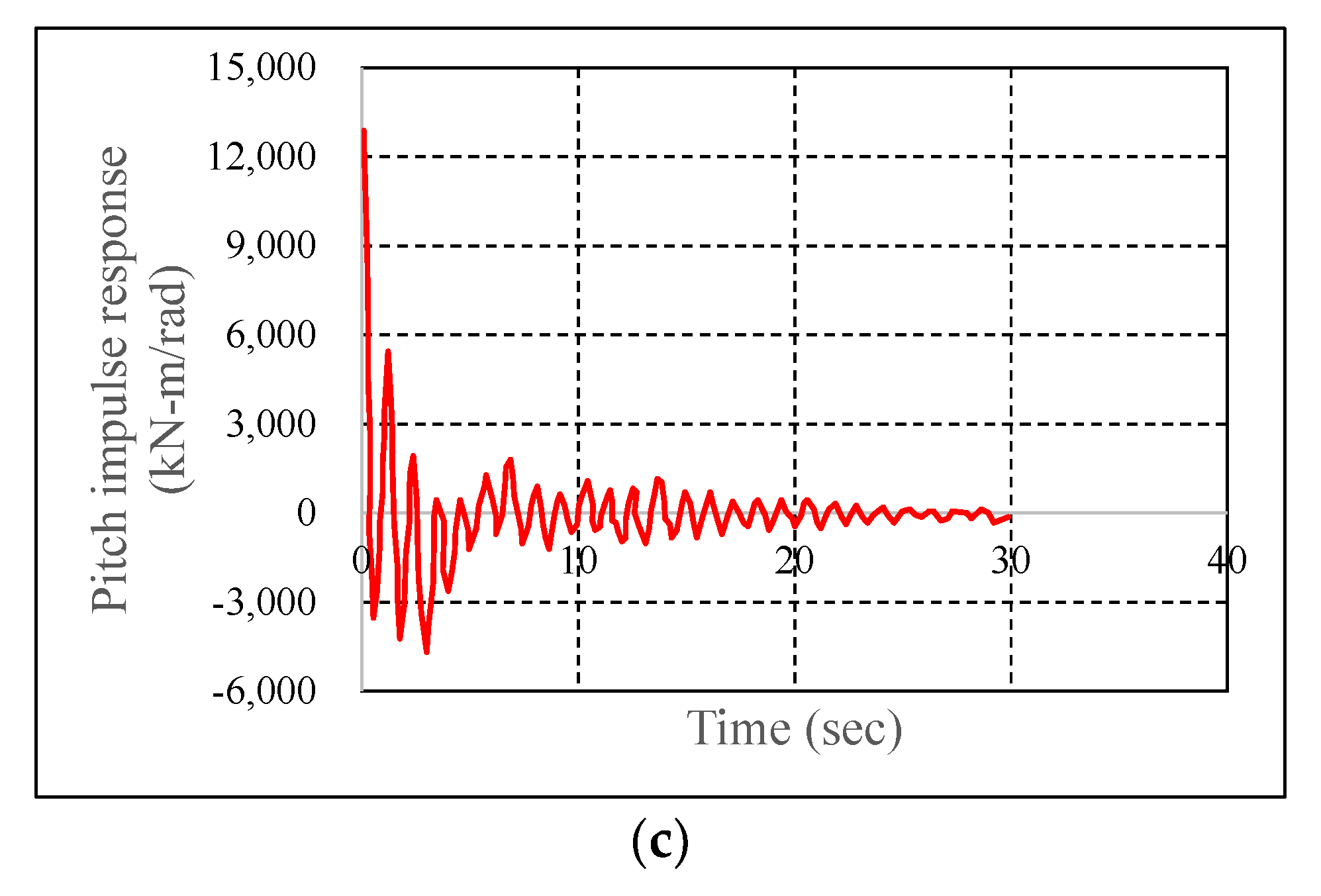
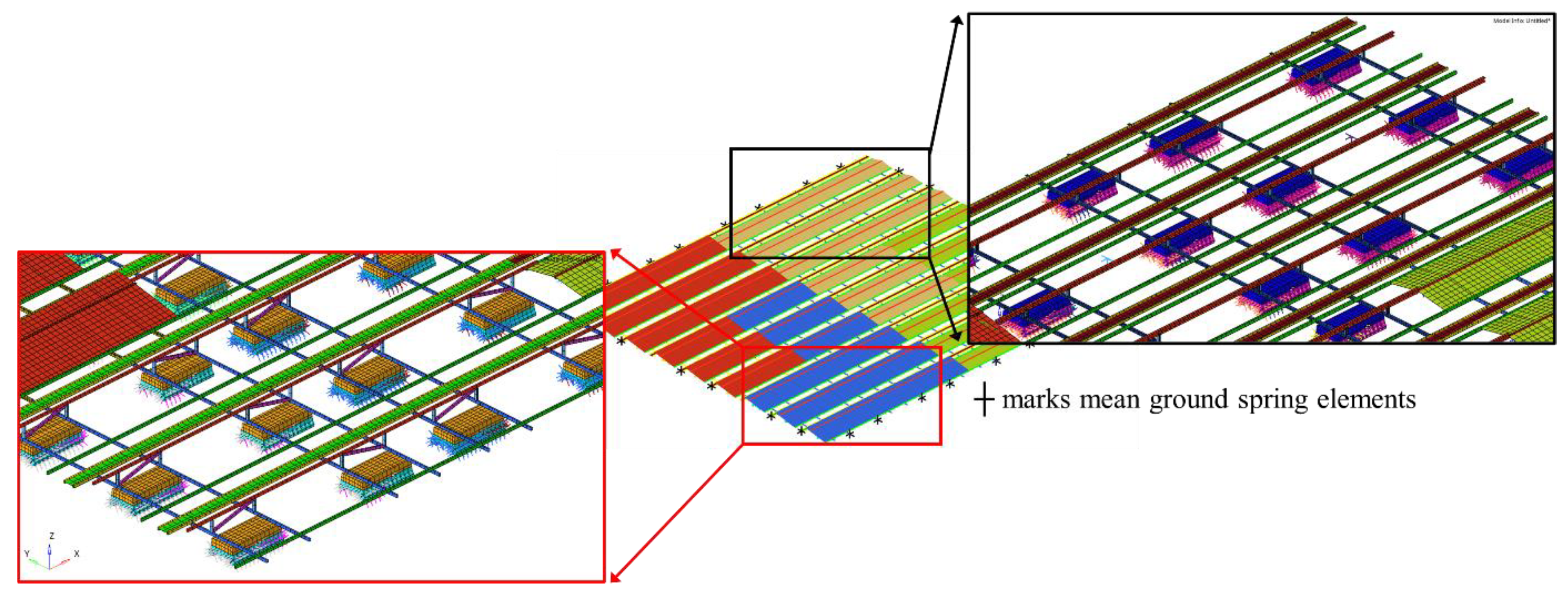
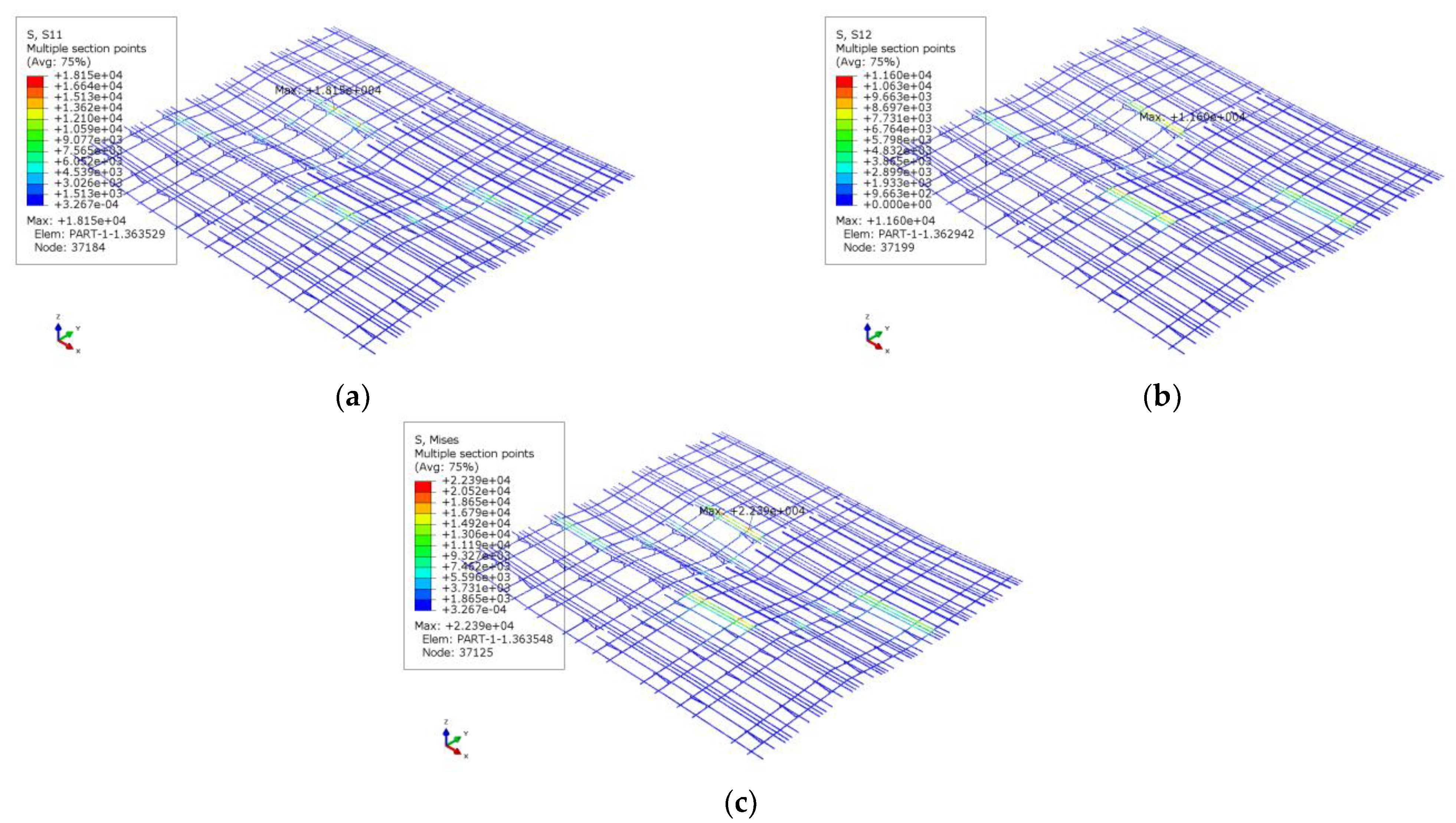
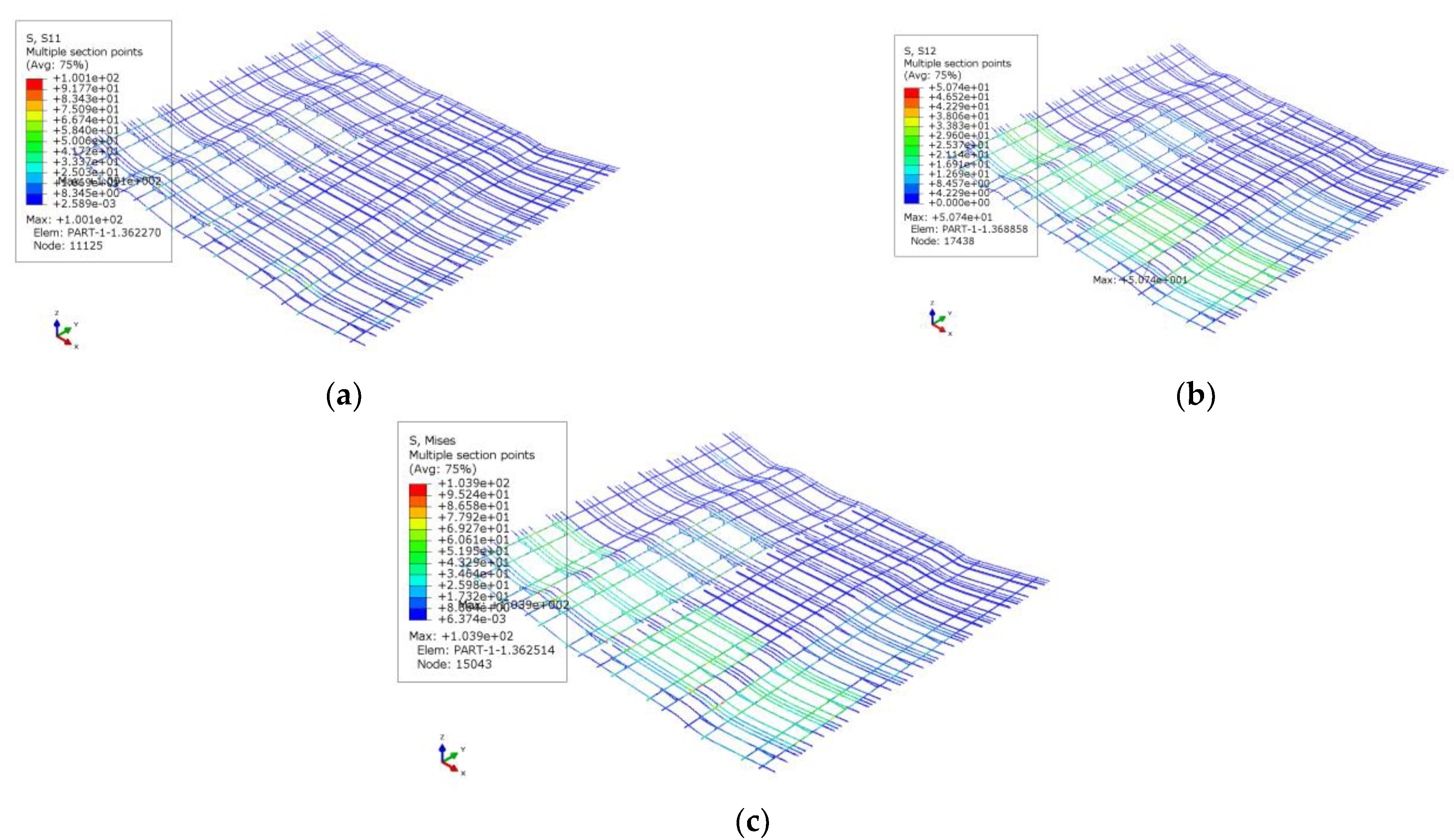


| Items | Unit | Value |
|---|---|---|
| Nominal diameter | m | 0.024 |
| Minimum breaking load | kN | 57.0 |
| Mooring density | kg/m | 0.27 |
| Unstretched length | m | 9.513 |
| Young’s modulus | MPa | 1800 |
| Axial stiffness | N/m | 6.53 × 104 |
| Member | Number of Wet Panels (Diffraction) | Number of Dry Panels (Non-Diffraction) |
|---|---|---|
| PV module | 0 | 270 |
| PE buoy | 21,312 | 6360 |
| Total | 21,312 | 6630 |
| Member | M1 (Uneven Mass Dist.) | M2 (Even Mass Dist.) | |
|---|---|---|---|
| Displacement (kg) | Sub-plant FRP-SHD | 2817.4 | 3934.4 |
| Sub-plant POS-SHD | 3254.6 | 3934.4 | |
| Sub-plant FRP-GBL | 3241.0 | 3934.4 | |
| Sub-plant POS-GBL | 3934.4 | 3934.4 | |
| Center of mass in z-direction (m) | 0.4083 | 0.3750 | |
| (kg-) | 8.6481 105 | 1.0284 106 | |
| (kg-) | 1.1313 106 | 1.3394 106 | |
| (kg-) | 1.9910 106 | 2.3669 × 106 | |
| Member | Value |
|---|---|
| Water depth (m) | 4.0 |
| Seawater density (kg/) | 1025.0 |
| Gravity (m/) | 9.81 |
| Wave frequency range (rad/s) | 0.1–7.0 |
| Number of wave frequency | 40 |
| Viscous damping ratio | 0.0 |
| Member | Types of Elements | Number of Elements |
|---|---|---|
| Frame | Beam (B31) | 11,955 |
| PE buoy | Solid (C3D8) | 30,6175 |
| PV module | Shell (S4) | 3456 and 59,166 |
| Hinge joint | Pin-type MPC | 86 |
| Fairlead point | Spring | 140 |
| Bonding bet. frame and buoy | Kinematic coupling | 1476 |
| Sum | 382,454 | |
| Member | Density (M1) | Elastic Modulus (GPa) | Poisson Ratio | Yield Strength (MPa) |
|---|---|---|---|---|
| FRP Frame | 1.878 102 | 25 | 0.4 | 600 |
| POSMAC frame | 7.850 102 | 206 | 0.3 | 600 |
| PE buoy | 3.000101 × 101 | 0.043 | 0.2 | n/a |
| PV panel | 2.188 102 | 50 | 0.2 | n/a |
| Item | Value |
|---|---|
| Wave height (m) | 1.50 |
| Wave period (s) | 18.90 |
| Current speed (m/s) | 0.32 |
| Wind speed (m/s) | 36.16 |
| Case | Wave Dir (Deg) | Current Dir (Deg) | Wind Dir (Deg) | Gravity (G) | Buoyancy (N) |
|---|---|---|---|---|---|
| M1-S1 or M2-S1 | 0 | 0 | 90 | 1 | |
| M1-S2 or M2-S2 | 45 | 45 | 90 | 1 | |
| M1-S3 or M2-S3 | 90 | 90 | 90 | 1 |
| Case | FRP (MPa) | POSMAC (MPa) |
|---|---|---|
| M1-S1 | 4754 | 22,390 |
| M1-S2 | 4436 | 20,550 |
| M1-S3 | 4485 | 20,100 |
| M2-S1 | 22 | 104 |
| M2-S2 | 86 | 288 |
| M2-S3 | 34 | 339 |
Publisher’s Note: MDPI stays neutral with regard to jurisdictional claims in published maps and institutional affiliations. |
© 2022 by the authors. Licensee MDPI, Basel, Switzerland. This article is an open access article distributed under the terms and conditions of the Creative Commons Attribution (CC BY) license (https://creativecommons.org/licenses/by/4.0/).
Share and Cite
Li, C.B.; Choung, J. Structural Effects of Mass Distributions in a Floating Photovoltaic Power Plant. J. Mar. Sci. Eng. 2022, 10, 1738. https://doi.org/10.3390/jmse10111738
Li CB, Choung J. Structural Effects of Mass Distributions in a Floating Photovoltaic Power Plant. Journal of Marine Science and Engineering. 2022; 10(11):1738. https://doi.org/10.3390/jmse10111738
Chicago/Turabian StyleLi, Chun Bao, and Joonmo Choung. 2022. "Structural Effects of Mass Distributions in a Floating Photovoltaic Power Plant" Journal of Marine Science and Engineering 10, no. 11: 1738. https://doi.org/10.3390/jmse10111738
APA StyleLi, C. B., & Choung, J. (2022). Structural Effects of Mass Distributions in a Floating Photovoltaic Power Plant. Journal of Marine Science and Engineering, 10(11), 1738. https://doi.org/10.3390/jmse10111738









